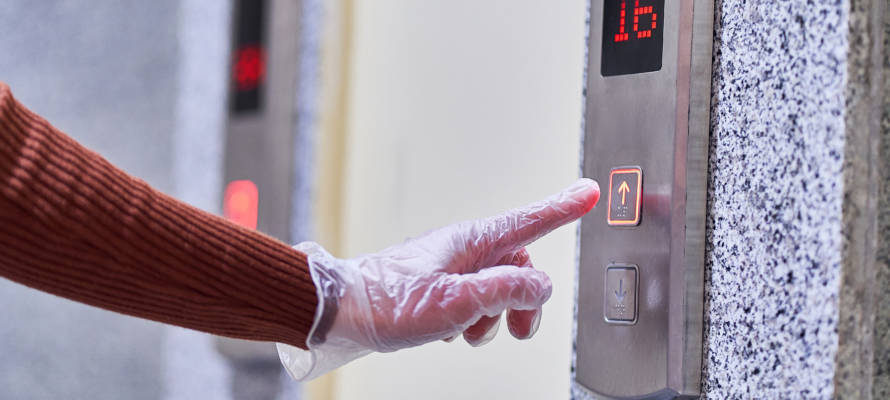Israeli researchers are developing voice-activated devices so that people won’t need to touch germ-covered surfaces like elevator buttons, ATM touchpads, and intercoms, on which viruses like COVID-19 can be transmitted.
By Abigail Klein Leichman, ISRAEL21c
The Covid-19 crisis will pass, but some things will never go back to normal. We will remain wary of elevator buttons, ATM touchpads, intercoms, fingerprint scanners, employee timeclocks and all other surfaces touched by countless hands.
The Israeli startup Sonarax is ready for that new touchless reality with a ready-to-install ultrasonic data-transmission technology.
You’ll touch only your smartphone in order to check in, check out or ride the elevator.
“Ultrasonic data connectivity is a great solution for many tasks,” Sonarax Chief Commercial Officer Nimrod May tells ISRAEL21c.
The machine-to-machine technology uses soundwaves to transfer data between any devices equipped with a speaker and microphone.
For the data exchange to work, Sonarax’s SDK (software development kit) must be implemented on both sides. On your mobile phone it can be added to an existing or dedicated app.
So, for example, employees will hold their smartphone near an access control device to enter the office building, summon the elevator and “punch” a timeclock. The audio signals communicate automatically once the user opens the phone’s speaker.
Delivering Data Over Soundwaves
“It all began with Roni Papo, an engineer from the Technion, who had the vision and passion to harness soundwaves in order to deliver data,” says May. “He developed algorithms to send data in small packages over soundwaves.”
Papo chose an ultrasonic range that humans cannot hear (it doesn’t bother dogs either, says May).
Incubated in 2016 at Haifa’s hiCenter Ventures, Sonarax signed integration agreements with leading semiconductor companies such as Cadence, Knowles and Ceva.
Clients are using the startup’s award-winning technology for touchless access, payments, authentication, location-based services, marketing promotions and indoor positioning.
Some European universities have embedded the SDK into classroom touchpads and student apps for attendance verification.
A European museum put it on the visitor app for indoor navigation and information. Fans at an Israeli sports stadium used it to trigger a sonic lightshow in tandem with the stadium’s PA system.
Sonarax and Covid
And then came the pandemic.
“Four months ago, an invisible enemy began affecting our lives and making us rethink the way we interact with our physical surroundings,” May says.
“We became more aware of potential dangers of pressing the buttons on a vending machine, ATM or pedestrian crosswalk.”
Manufacturers of elevators and access control systems – even casino games – have approached Sonarax to help them offer touch-free options.
“People will use their mobile phone as a third hand,” says May.
Sonarax’s technology also provides an effective social-distancing tool, says May.
“Soundwaves can measure distance and positioning. That facilitates anyone launching an app to make sure people are maintaining proper social distance. Our SDK would calibrate the parameter and notify people if they are crossing the line.”
Google and Apple recently announced a joint venture to enable contact tracing using Bluetooth technology.
However, “Bluetooth is not as good as what we offer,” Sonarax VP Product Ariel Ben Lulu tells ISRAEL21c.
“Ultrasonic transmission is much more accurate, secure, private and cost effective. It’s even ‘greener’ because it has zero radio frequency emissions.”
What Makes it More Accurate?
“Unlike Wi-Fi and Bluetooth, which use high-frequency radio waves that cross through walls or other hard surfaces, ultrasonic waves don’t cross walls and can be contained in any defined space,” Ben Lulu explains.
“If someone in the next office has corona, Bluetooth or Wi-Fi will indicate that the person is right next to you. Our solution will not falsely read and report such data because we are able to differentiate and accurately tell apart locations down to a distance of 30 centimeters. So indication of risk is much more reliable.”
Under the management of high-tech entrepreneur Uri Heller, Sonarax has 14 employees in its Haifa office. At the nearby Technion, students continue to find additional uses for the technology.
“Helping to slow down or stop the virus transmission risks involved in sharing touchpads, whether for gating access or making payments, is our greatest motivator in making this technology available,” said Heller.
“Flattening the curve through everyday social distancing practices is what all communities are striving for, and institutions and enterprises are looking for practical answers that don’t require heavy investments or major retooling of their existing systems. We’re here to provide those answers.”
Faster transmission
Sonarax is not without competition. Ultrasonic data transmission also forms the basis of two other companies, Listnr and Copsonic.
Ben Lulu asserts that Sonarax technology is 10 times faster and therefore more reliable.
“A big issue is the speed at which we can transmit data. We can transmit 1,000 bits per second, while our competitors can only transmit 200 bits per second,” he says.
“And we have unique capabilities, including the ability to work during movement, meaning you don’t need to stay still while communicating.”
Concludes May: “This is our time to prove that ultrasonic connectivity is an amazing technology that can make the world a better place.”
